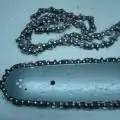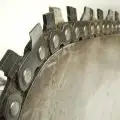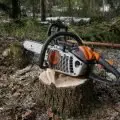In addition to being a safety problem, a chainsaw with a dull, improperly maintained chain won’t cut effectively or cleanly. A chainsaw needs to be regularly and correctly maintained in order to function effectively, just like any other tool in your toolbox. The majority of DIYers can learn how to sharpen a chainsaw so they can tackle the work on their own and save the money of hiring a professional to sharpen chainsaw.
In this article, you will learn how to sharpen chainsaw blade and check for dull or sharpened teeth if you’ve found that your chainsaw isn’t cutting as smoothly and cleanly as it previously did.
Table of Contents
- Sharpening a Chainsaw Chain
- Tools Required & Preparation
- How to Sharpen a Chainsaw
- Electric Chainsaw Sharpeners
- Chainsaw Blade Maintenance Tips
- FAQs (Frequently Asked Questions)
Sharpening a Chainsaw Chain
Sharp chainsaws are simpler and safer to use, and they also result in less damage to the tool and greater productivity. If a chainsaw chain has to be sharpened, there are warning signals to look out for. If you realize the saw is spitting out dust instead of crisp wood chips, take action and fetch a sharpener.
The teeth on the chain are dull if you notice that you have to exert greater physical effort when cutting into wood. If the dull chain pulls more to one side than the other rather than a straight line, that is another sign that the chain needs to be sharpened. To align the cutting teeth, you will need to sharpen the chainsaw chain.
For how to sharpen a chainsaw, there are two methods. First, an electric chainsaw sharpener can be used to complete the task. These devices are necessary if you regularly fell trees. The other choice is the hand sharpening process, which combines employing sharpening files, muscle, and sweat.
The instructions provided in this article concentrate on the manual way of sharpening a chainsaw using a chainsaw sharpening tool, which is more prevalent and available to DIYers because electric sharpeners are typically employed by tradesmen. However, we will lightly discuss electric sharpening further down the page.
To conduct any chainsaw maintenance tasks, they require a basic understanding of the tool’s component parts. Learn more the parts of a chainsaw in our guide!
Tools Required & Preparation
- Chainsaw file
- Screwdriver
- Towel
- Mineral spirits
- Gloves
- Safety glasses
- Vise
Almost all chainsaw blades are unique. Rarely will you find two blades that are identical due to differences in the chain length, cutting tooth size and angle, depth of the guide links, and other elements. You must precisely know your chainsaw blade because there are so many different chainsaw blade variables. Read your chainsaw’s owner’s manual thoroughly, and note the chain size.
Usually, if you search for your chainsaw model and make online, you can locate the manual by adding the word “manual” to the search. If you’re unsure of the size of the blade you need for your saw, take it to a shop with experience. Usually, they can assist you in locating the precise chainsaw blade for your model. You can find the information for your blade on the packaging if you have purchased an extra blade.
The diameter and proper angle of the cutting teeth are the first details you need to be aware of when sharpening, and the two main factors. The size of the file you need to sharpen teeth depends on the diameter of the teeth. The most common blade diameters are 5/32″ (4mm), 3/16″ (4.75mm), or 7/32.” (5.5mm). However, your blade will have a bearing on the size. Additionally, the proper angle of the teeth can range from around 10° to about 35°.
- Swiss double-cut file design with precision cutting-tooth and fewer teeth per inch than competitive files
Prices pulled from the Amazon Product Advertising API on:
Product prices and availability are accurate as of the date/time indicated and are subject to change. Any price and availability information displayed on [relevant Amazon Site(s), as applicable] at the time of purchase will apply to the purchase of this product.
If you are doing this in a field, I suggest having a stump vise handy to hold your chainsaw bar in place while you sharpen. Use a guide handle if you’d like for the file. Additionally, multiply the file handle by the file size. It will assist in maintaining the file’s proper positioning during sharpening. Learn more in our chainsaw file sizes chart guide!
- Saw vise: This chainsaw vise is the perfect accessory for tree care professionals in the field, letting you tackle routine chainsaw and pole saw maintenance on the job. Use with any chainsaw sharpener
Prices pulled from the Amazon Product Advertising API on:
Product prices and availability are accurate as of the date/time indicated and are subject to change. Any price and availability information displayed on [relevant Amazon Site(s), as applicable] at the time of purchase will apply to the purchase of this product.
The raker guides need to be checked and filed down once the teeth are sharp. For this work, a flat-file and a rake depth gauge are required. You won’t really need much else to successfully sharpen your chainsaw.
Prices pulled from the Amazon Product Advertising API on:
Product prices and availability are accurate as of the date/time indicated and are subject to change. Any price and availability information displayed on [relevant Amazon Site(s), as applicable] at the time of purchase will apply to the purchase of this product.
Safety Gear
In woodworking, we always want to be secure and safeguard ourselves. It is best to put on heavy work gloves because we will be handling and moving the sharp chain. To prevent metal shavings or other foreign objects from entering our eyes, eye protection is absolutely necessary.
You might wish to wear some form of eye magnifier in addition to eye protection. This will allow you to boost your ability to see more clearly, making it simple to evaluate each cutting tooth as you sharpen the chainsaw blade. Learn how to use a chainsaw safely in our guide!
Choosing the Right Chainsaw File
Chainsaw files are produced in a range of sizes that correspond to the dimensions and shapes of the chainsaw teeth. It may be challenging to correctly sharpen the blade if the file is too large or too little. The most common file sizes are 4 millimeters, 4.8 millimeters, and 5.5 millimeters, although there are many other sizes available. Always refer to your user manual to confirm you are using the correct file.
- 4 mm: Used with chainsaws that have a 0.25-inch chain pitch, with the code number on the depth gauge being 1.
- 4.8 mm: Used with chainsaws that have a 0.325-inch chain pitch, with the code number on the depth gauge being 2.
- 5.5 mm: Used with chainsaws that have a 0.404-inch chain pitch, with the code number on the depth gauge being 4.
Instead of sourcing all your tools individually, it may be worth purchasing a chainsaw sharpener file kit like the one below from Oregon which includes a flat file and a variety of other files. They conveniently include everything you need to sharpen any common size.
- Chainsaw chain sharpener kit with a heavy-duty, compact, and compartmentalized case which keeps everything in place and makes it easy to find the tool you need quickly
Prices pulled from the Amazon Product Advertising API on:
Product prices and availability are accurate as of the date/time indicated and are subject to change. Any price and availability information displayed on [relevant Amazon Site(s), as applicable] at the time of purchase will apply to the purchase of this product.
There’s a variety of chainsaw chain sizes available. Visit our guide to learn more about them!
This might also be relevant to you: How Long Do Chainsaw Chains Last.
How to Sharpen a Chainsaw
How to Sharpen a Chainsaw Summary
Clean the chainsaw chain
Clean the chain thoroughly by removing any oil, dirt, and debris using screwdriver and an old towel. before starting work.
Set the chain tension
In order to avoid issues while you operate, the chain tension on your chainsaw must be set to a precise value, not too tight nor too loose.
Stabilize the chainsaw
You must firmly steady the chainsaw before starting to file the chain in order to achieve the best results.
Begin sharpening at the shortest cutter
Find the chain’s shortest cutter blade, which are the ones with flat tops, and start here.
Stroke the teeth at an angle
Slide the file across the teeth, slightly twisting it to produce friction as you go. Hold the file at the same angle that the notch was first ground or most recently filed.
Sharpen the other side of the chain
Reverse the saw now, and start filing each of the teeth you ignored during your initial pass.
Check your depth gauges
Check the rakers to ensure they’re shorter than the neighboring cutter.
1. Clean the Chainsaw Chain
Put on the necessary protective gear, such as work gloves and safety glasses, when you’ve acquired a file of the suitable size. Clean the chain thoroughly by removing any oil, dirt, and debris before starting work. To do this, get a screwdriver and an old towel. You might also need to apply mineral spirits, depending on the state of the chain.
As you clean the chain, inspect it thoroughly. The chain could be dangerous to use if one or more of the teeth are broken. You might need to first fix or replace the chain before attempting to sharpen a chainsaw. Learn more about cleaning in our how to clean a chainsaw guide!
2. Set the Chain Tension
In order to avoid issues while you operate, the chain tension on your chainsaw must be set to a precise value. Chainsaw kickback and the chain being flung off the guide bar are both made more likely by a slack chain. If the chain is excessively tight, the pieces may not move at all or they may move with more friction, which generates more heat. Parts that are overheated have a higher chance of catching fire and have a much shorter lifespan.
Finding and adjusting the tensioning screw on the side or front of the saw will help you prevent this problem. You can move the screw in either a clockwise or counterclockwise direction to tighten or loosen the chain. To check the chain, pull it from the bottom of the guide bar until one or two links start to separate from the bar.
When the chain is ready for use, it should snap back into place as soon as it is released. The chain must be tightened if you are unable to draw it away from the bar. If the chain does not automatically return to its original position, it needs to be tightened.
3. Stabilize the Chainsaw
You must firmly steady the chainsaw before starting to file the chain in order to achieve the best results. Some people opt to secure the chainsaw in a vise with the guide bar being held in place by clamps so that the chain may freely rotate. Or, a buddy can hold the tool firmly while you work.
4. Begin Sharpening at the Shortest Cutter
Find the chain’s shortest cutter blade, which are the ones with flat tops. With the chainsaw sharpener, you will want to start here. You can begin with any tooth on the chain if the cutters are of the same height. To ensure that you continue to work in the same chainsaw chain direction, mark the first tooth you sharpen with a pencil, marker, or even nail polish.
5. Stroke the Teeth at an Angle
Insert the file into the cutter’s head’s notched area. Slide the file across the teeth, slightly twisting it to produce friction as you go. Hold the file at the same angle that the notch was first ground or most recently filed. Regarding assistance in calculating the correct angle, consult a chart for chainsaw sharpening angles. File each subsequent cutter around the chain starting from that first one.
6. Sharpen the Other Side of the Chain
Reverse the saw now, and start filing each of the teeth you ignored during your initial pass. The flat tops of all the cutters should be roughly the same length when you’re done.
7. Check Your Depth Gauges
Lastly, check the rakers, which are the curved links between the cutters. Each raker, also known as a depth gauge, should be shorter than the neighboring cutter. If you come across a depth gauge whose height is higher than the cutter closest to it, file down the raker until it is about 1/10 of an inch lower in height.
Electric Chainsaw Sharpeners
If you’re using an electric chainsaw sharpener, you’ll need to measure the chain’s pitch and gauge in order to choose the right sharpening stone for your chainsaw and the right tooth angle.
To hold the chain in position, set it on the sharpener and tighten the vise. You can lower the grinding wheel to the chain to sharpen the current cutting tooth once all the angles have been set in accordance with the grinding angles chart, which is usually included with an electric chainsaw sharpener.
To align the next cutting tooth, loosen the vice and slide the chain; once the tooth is lined up, tighten the vise and sharpen it with the grinding wheel. I’ll leave you with these 3 important tips if you’re using an electric chainsaw sharpener:
- For the proper sharpening configuration, always measure the chainsaw chain and consult the product handbook.
- To keep the grinding wheel from making contact with the chain chassis, be careful to set the wheel depth stop.
- To prevent switching back and forth, finish all of the right-hand cutting teeth first, then all of the left-hand cutting teeth.
Chainsaw Blade Maintenance Tips
Various chainsaws work slightly differently and have different maintenance needs, whether you use your chainsaw occasionally to cut firewood or frequently to maintain the forested areas on your property. To learn about the requirements of your particular model, read the chainsaw’s instruction booklet.
It is nearly always true that lubricating a chainsaw with a petroleum-based chainsaw bar and chain oil is either required or advantageous. This simply entails putting the lubricating oil into the chain oil reservoir of the saw, where it slowly disperses to keep the saw running smoothly as you work.
Periodically check the motor and chain, applying lubricant as required. Verify sure there is enough oil in the tool’s reservoir on a regular basis. Examine the guide bar that keeps the chain in position. During use, it could twist or bend.
Every time you start up your chainsaw, make sure the guide bar is intact to prevent issues. It’s a good idea to occasionally spot-check this important component of what is, after all, a potent and potentially hazardous tool, even while you’re working.
FAQs (Frequently Asked Questions)
Is it worth sharpening a chainsaw?
Sharp chainsaw chains are easier to operate with, thus it is definitely worthwhile to get your chainsaw chain sharpened. Sharp blades on your chain will enable cleaner cuts through wood with less effort. Chainsaw chains may be sharpened several times with no expense.
How often does a chainsaw need to be sharpened?
If a tool is used frequently, it will need to be sharpened frequently to prevent the blade from becoming a dull chainsaw blade. A chainsaw that is rarely used may only need to be sharpened once a year. A chainsaw blade will typically keep its cutting edge after actively cutting through wood for roughly three hours.
Can you sharpen your own chainsaw blade?
Yes, you can sharpen your chainsaw blade using either a combination of sharpening files, muscle, and sweat, or an electric chain sharpener. The latter should be used if you’re regulalrly felling trees, while the former is sufficient if you don’t use the chainsaw as frequently.









